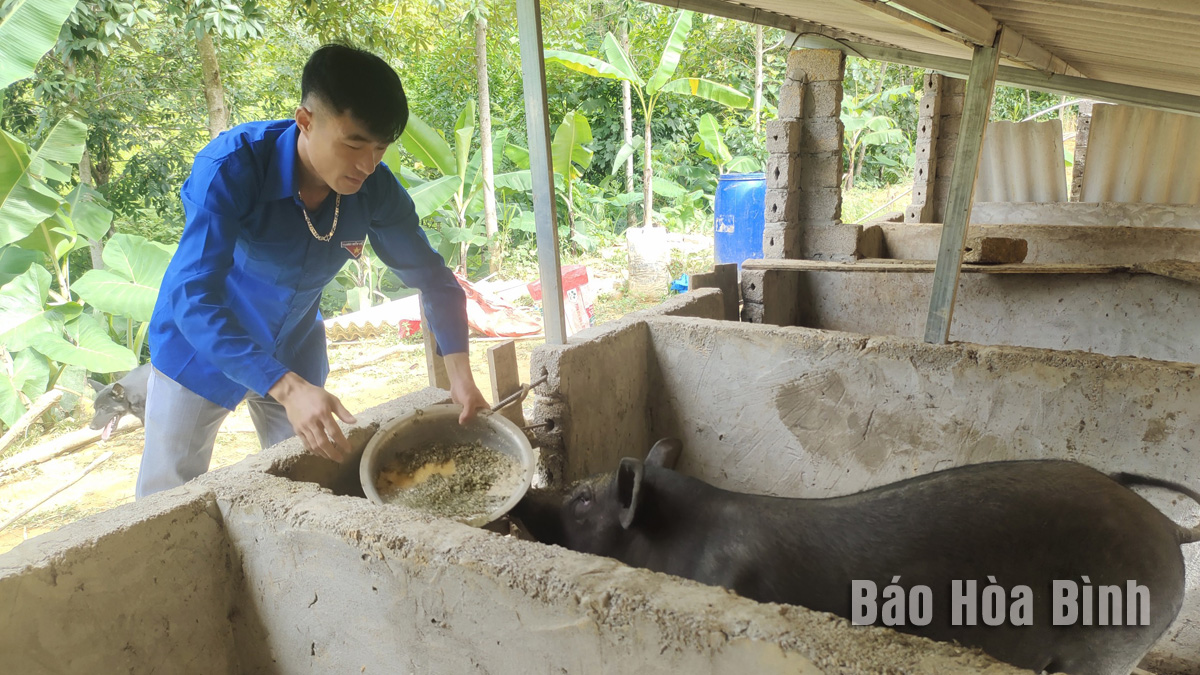
At this time, traders for local specialty pigs to serve the Lunar New Year. This year, the price of local pigs is stable. Favorable consumption has brought happiness to farmers in Hoa Binh province.
Mr. Lo Van Tuat's family in Khem hamlet, Doan Ket commune, Da Bac district sold 27 local black pigs and had money to buy Tet goods.
Mr. Lo Van Tuat's family in Khem hamlet, Doan Ket commune, Da Bac district sold 27 local black pigs and had money to buy Tet goods. Da Bac district, Hoa Binh province develops local black pig farming. With favorable conditions for grazing land, food sources, and purebred local pig breeds, local black pigs in the Da Bac district are favored by customers because of their delicious meat quality.
In Doan Ket highland commune, Da Bac district, the small-eared black pig breed is quite popular. Many households focus on developing this pig breed into their main economic sector, selling for 100 - 110 thousand VND/kg.
In Yen Thuy district, there are also many households focusing on raising specialty and indigenous pig breeds. Ms. Vu Thi Nga, Trung Hoa hamlet, Phu Lai commune, has a farm raising black and wild pigs with a quantity of several hundred pigs/year. The family's consumption of pigs is quite favorable, especially during holidays and Tet when customer demand increases.
In general, this year's Tet pig market is still quite vibrant, pig consumption is favorable, and selling prices are stable. Currently, the price of wild boar ranges from 100 - 150 thousand/kg of live pig. Not only sold to customers who come to buy at the farm but Hoa Binh local pigs are also shipped to customers from far away and in neighboring provinces.
With delicious meat quality, local specialty pigs are one of the most popular foods during Tet. Comrade Tran Tien Truong, Deputy Director of the Provincial Department of Animal Husbandry and Veterinary Medicine, said: Currently, indigenous pig breeds are commonly raised, especially in highland communes in the province, with convenient food sources. and grazing conditions. Not only during Tet, the selling price of local pigs tends to be stable, so it brings high economic efficiency.
In Hoa Binh province, several cooperatives are raising and consuming indigenous pigs, with output becoming more and more stable. This is also livestock that the province focuses on raising on a household scale, especially in highland areas with suitable conditions. In addition, at this time, the price of white pigs also increases day by day, reaching over 60 thousand VND/kg on the farm, and about 58 thousand VND/kg in households. Such selling prices are a positive signal for farmers when the Lunar New Year has arrived.
Under the blazing early summer sun, the construction site of Nhuan Trach Industrial Park (IP) in Luong Son district is abuzz with activities from dawn to dusk, a testament to the determination of the investor to meet their construction targets on schedule.
In light of the slow disbursement rate of public investment recorded since the beginning of the year, Hoa Binh leaders are stressing the urgent need to identify bottlenecks at each project level and promptly implement targeted solutions to remove obstacles delaying progress.
In May 2025, the total import and export turnover of Hoa Binh Province is estimated to exceed USD 334 million. In which exporting reached nearly USD 196 million, accounting for approximately 40% of the annual target, marking a 17% increase compared to the same period last year. Imports are estimated at nearly 139 million USD, reflecting a 15% growth.
As agriculture increasingly demands professionalism and market adaptability, changing farmers' mindsets from traditional to modern production through science, technology, and skill mastery is key to sustainable development.
During the period 2021 - 2025, Hoa Binh province has been exported over 272.000 tons of agricultural, forestry, and aquatic products, with a total value exceeding 3.266 billion VND. Currently, there are 21 businesses, cooperatives, and cooperative groups in the province with products exported to international markets, including 15 agricultural product facilities and 6 forestry product facilities.



